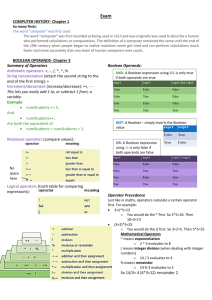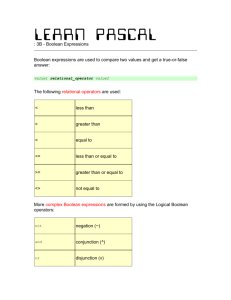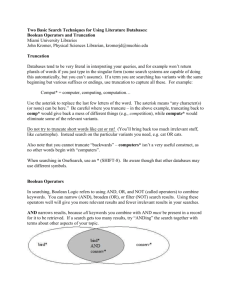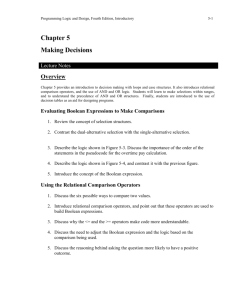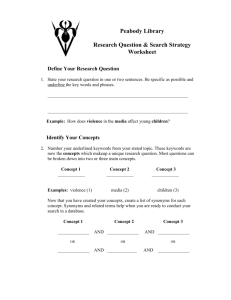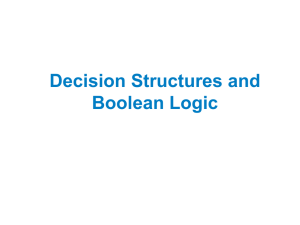Chapter 1
advertisement
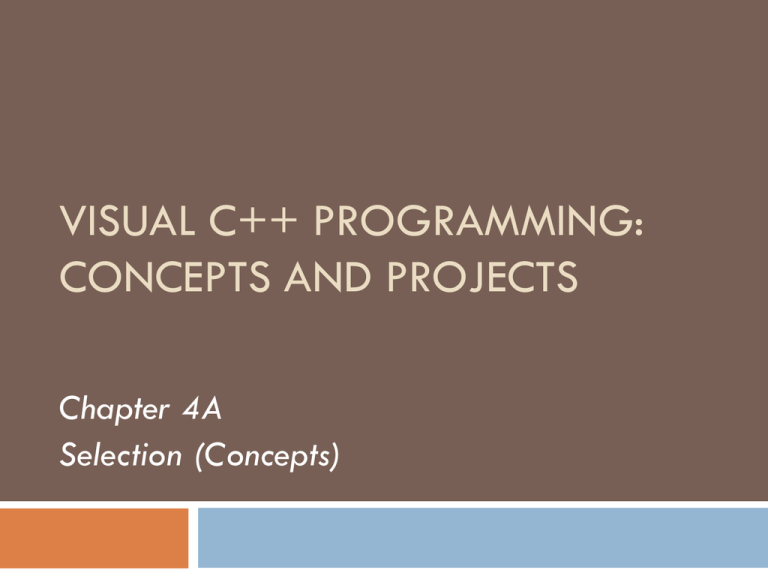
VISUAL C++ PROGRAMMING:
CONCEPTS AND PROJECTS
Chapter 4A
Selection (Concepts)
Objectives
2
Discover what control structures are and why they
are important
Learn the difference between sequential control
structures and selection control structures
Compare values using relational operators
Use an if statement to select single alternative
Use an if...else statement to select one of two
alternatives
Visual C++ Programming
Objectives (continued)
3
Develop an understanding of logical operators and
their use in complex expressions
Create nested control structures
Become familiar with multiple selection and the
switch statement
Visual C++ Programming
Control Structures
4
Control structures
Are
the fundamental building blocks of all programs
Control the flow of instruction execution
Three types
Sequential
Every
statement is executed in sequence
Selection
Allows
you to skip statements
Repetition
Allows
you to repeat statements
Visual C++ Programming
5
Visual C++ Programming
Sequential Control Structures
6
Linear in nature
Each statement is performed in order
No statement is skipped
No statement is repeated
The simplest programs tend to be sequential in
nature
Visual C++ Programming
7
Visual C++ Programming
8
Visual C++ Programming
Selection Control Structures
9
Provide alternative course of action
Single
alternative selection
Double alternative selection
Multiple alternative selection
A Boolean expression is evaluated and used to
select a course of action
Visual C++ Programming
10
Visual C++ Programming
Relational Operators
11
A Boolean expression often compares two variables
The relationship between two variables is evaluated
using relational operators
The equal to (==) and not equal to (!=) operators
have lowest precedence
All relational operators are binary (have two
operands)
All relational operators are left-to-right associative
Visual C++ Programming
12
Visual C++ Programming
13
Visual C++ Programming
Using if Statements to Provide a Single
Alternative
14
Syntax: keyword if followed by a Boolean
expression)
If a Boolean expression is true then one or more
statements are executed
If only one task is to be executed it can be listed
after the Boolean expression
If more than one task is to be executed they must
be enclosed in curly brackets { }
Visual C++ Programming
15
Visual C++ Programming
16
Visual C++ Programming
Using if…else Statements to Provide
Two Alternatives
17
The keyword else is used to separate the two
alternatives
If the Boolean expression is true then the statements
in the first alternative are selected
If the Boolean expression is false then the
statements in the second alternative are selected
Visual C++ Programming
18
Visual C++ Programming
19
Visual C++ Programming
Logical Operators
20
Operators with Boolean operands
Include operators for “and”, “or” and “not”
Examples from everyday life. You may have an
exam on Monday but want to go to a concert in
another city this weekend.
If
it is true that I have an exam, then I will not try to get
concert tickets
If it is not true that I have an exam, then I will try to get
tickets.
Visual C++ Programming
Logical Operators
21
Operators with Boolean operands
Include operators for “and”, “or” and “not”
Logical operators
Not
(!)
And (&&)
Or (||)
Visual C++ Programming
The not Operator (!)
22
Reverses a Boolean value
Has highest precedence among logical operators
Uses the ! Operator
Example: !(score >= 60)
Assume
that score is 45. Then, the relational expression
score >= 60 is false, ! reverses the evaluation to true
Visual C++ Programming
23
Visual C++ Programming
24
Visual C++ Programming
The and Operator (&&)
25
Used with two Boolean operands – often relational
expressions
Lower precedence than not (!)
Example:
if
((score > 0) && (score <= 100))
The operands may both be true
The left operand may be true and the right operand
false
The right operand may be true and the left operand
false
Visual C++ Programming
26
Visual C++ Programming
27
Visual C++ Programming
The and Operator (&&) (continued)
28
If either the left or right operands are false then
the entire expression evaluates to false
The only way and expression evaluates to true using
the and operator (&&) is if both operands are true
Visual C++ Programming
29
Visual C++ Programming
Determining When to Use the and
operator (&&) and the or operator (||)
30
Consider a program with
two TextBoxes that must contain integers
and a ComboBox control to indicate which arithmetic
operation to perform
Possible errors of omission
No data in both TextBoxes
Data in one TextBox but not the other
No operation selected from the ComboBox
Example:
if ((txtLeft->Text == “”) &&
(txtRight->Text == “”))
Visual C++ Programming
31
Visual C++ Programming
32
Visual C++ Programming
33
Visual C++ Programming
34
Visual C++ Programming
The or Operator (||)
35
Unlike the and operator (&&) if either the left or
right operands are true then the entire expression
evaluates to true
The only way and expression evaluates to false
using the or operator (||) is if both operands are
false
Visual C++ Programming
36
Visual C++ Programming
37
Visual C++ Programming
Nested Control Structures
38
Nested control structures are ones that are placed
inside of another
Often used to implement multiple alternative
selection
A double alternative (if…else) statement within one
alternative of another if…else statement
Visual C++ Programming
39
Visual C++ Programming
40
Nested Control Structures
(continued)
Example: a ComboBox can be evaluated to
determine whether a selection has been made.
Valid ComboBox choices have index values starting
at 0
If no selection has been made the SelectedIndex
property of a ComboBox is set to -1 by default
Visual C++ Programming
41
Visual C++ Programming
42
Visual C++ Programming
Multiple Alternative Selection
43
Can be implemented with nested if…else
statements
The statements work like a filter
Whichever Boolean expression evaluates to true
first controls that path of execution that the program
has
The if…else if statement is made to accommodate
multiple selection without nesting
Visual C++ Programming
44
Visual C++ Programming
45
Visual C++ Programming
46
Visual C++ Programming
47
The switch statement also implements multiple
selection
Keyword switch is followed by an integral value
The integral value is used to determine which case
will be executed
Each case has statements that will be executed
Control will transfer out only it a break statement or
the end of the switch statement is encountered
Visual C++ Programming
48
Visual C++ Programming
49
Visual C++ Programming
Summary
50
Control structures are the building blocks of every
computer program
Types of control structures
•
•
•
Sequential – linear, no statement repeated or skipped
Selection – allows one or more statements to be
skipped under specific conditions
Repetition – the topic of Chapter 5
Visual C++ Programming
Summary (continued)
51
Types of selection structures
•
•
•
Single alternative (if statement)
Double alternative (if…else statement)
Multiple alternative
Nested
if…else statements
Multiple alternative if (if…elseif statement)
Switch statement
All if statements evaluate a Boolean expression
Visual C++ Programming
Summary (continued)
52
Boolean expressions often use relational operators
•
>, >=, <, <=, ==, !=
Complex Boolean expressions can be evaluated
using logical operators and (&&) and or (||)
Visual C++ Programming
